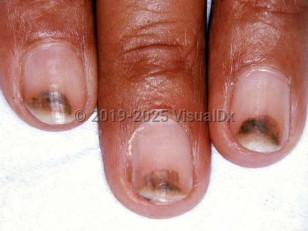Common causative medications include tetracycline derivatives, psoralens, aminolevulinic acid, griseofulvin, oral contraceptives, fluoroquinolones, voriconazole, or chloramphenicol. Photoonycholysis usually appears more than 2 weeks after exposure to the drug. It may occur as part of Segal's triad of photosensitivity of the skin, discoloration of the nails, and onycholysis. The latter, however, may appear independently in the absence of photosensitive reaction elsewhere. Pseudoporphyria is also usually drug-induced. While commonly associated with NSAIDs, antibiotics, and diuretics with sulfa moieties, it can also be seen in chronic renal failure (with or without hemodialysis) and with UVA exposure such as tanning beds, psoralen plus UVA (PUVA) therapy, and excessive natural sun.
There are 4 types of photoonycholysis:
- Several fingers are involved. The separating portion of the nail plate is half-moon shaped and concave distally with pigmentation of variable intensity and a well-demarcated proximal border.
- Only one finger is affected. There is a well-defined circular notch, which opens distally and has a brownish hue proximally.
- It occurs in the central part of the pink nail bed on several fingers. It is initially a round, yellow staining that turns red after 5-10 days.
- It is characterized by bullae under the nails with associated photoonycholysis due to tetracycline as well as in porphyria cutanea tarda, erythropoietic porphyria, erythropoietic protoporphyria, variegata porphyria, and in pseudoporphyria.
Photoonycholysis may also occur in children, Common culprits include tetracycline derivatives, griseofulvin, and voriconazole. In absence of an obvious medication, a workup for systemic causes including porphyrias should be performed.
Related topics: Onycholysis, Pseudoporphyria, Porphyria cutanea tarda



